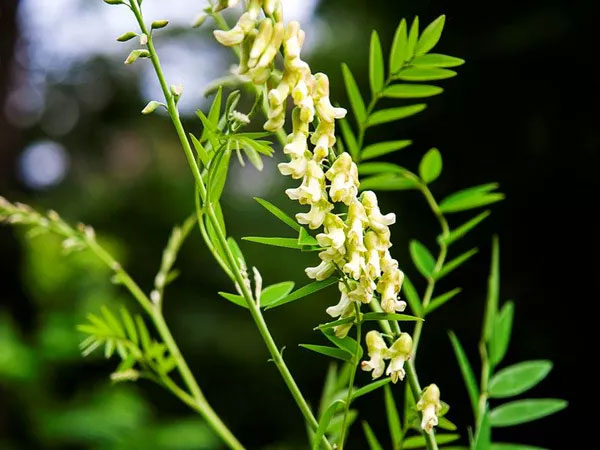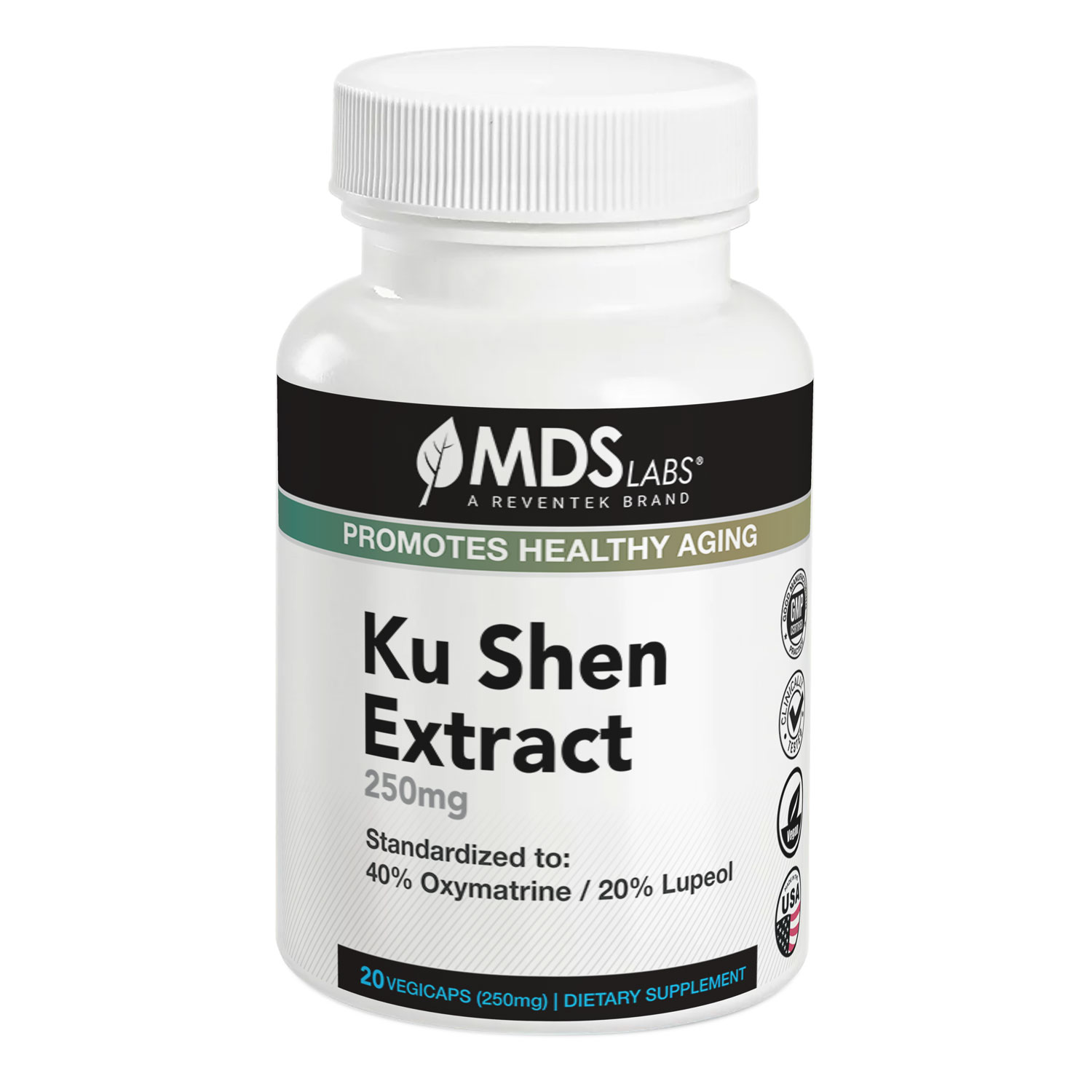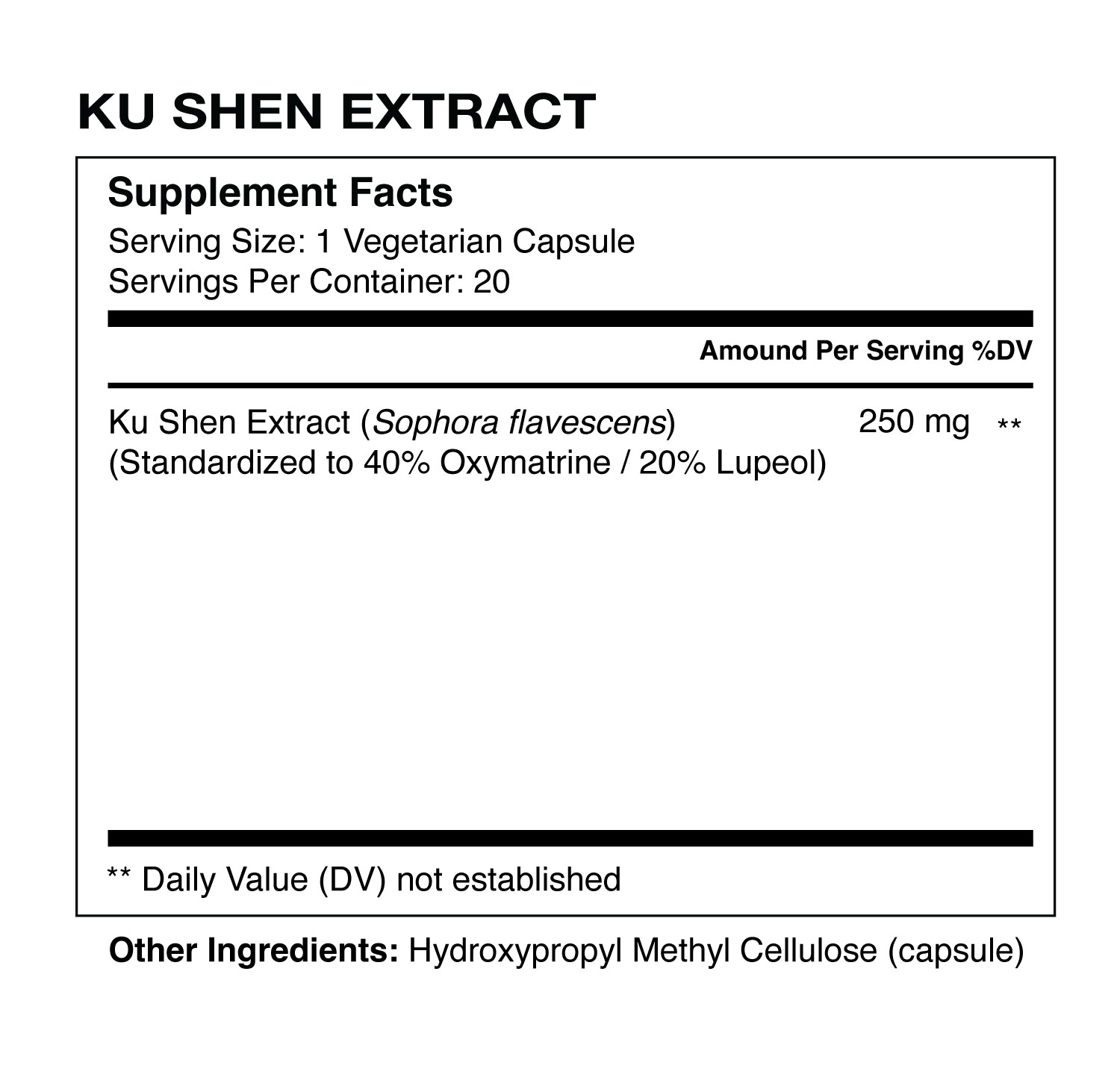Ku Shen Extract
(Sophora flavescens, 40% Oxymatrine / 20% Lupeol)
250mg Capsules
Sophora flavescens Examined: Harnessing Lupeol for Potential Anti-Aging Benefits*
Sophora flavescens, or Ku Shen, is used in traditional Chinese medicine, and holds potential for anti-aging due to its various bioactive compounds, including Lupeol, an active pentacyclic triterpenoid.* Lupeol exhibits a broad spectrum of pharmacological properties, which include anti-inflammatory and antioxidant effects.* The first total Synthesis was reported by Gilbert Stork [1]. Studies have shown that Lupeol is a powerful IL-4 Inhibitor, and can reduce cancer risk by as much as 20%.* In one study, Lupeol and its derivatives demonstrated higher anti-inflammatory activity than the commonly used non-steroidal anti-inflammatory drug indomethacin.* [2] There is convincing evidence that Lupeol is a highly potent chemopreventative and chemotherapeutic agent.* [2] Lupeol has also been found to have a contraceptive effect due to its inhibiting effect on the calcium channel of sperm (CatSper).* [3]
By mitigating oxidative stress and reducing inflammation, it is thought that Lupeol can help combat the underlying mechanisms that accelerate aging.* Oxidative stress leads to cellular damage and aging, while chronic inflammation is associated with a myriad of age-related issues.

Lupeol: Skin Benefits and Senolytic Potential*
Research indicates that Lupeol may have the ability to enhance skin health by modulating the expression of enzymes involved in the degradation of the skin's extracellular matrix, which can potentially reduce wrinkles and improve skin elasticity.*
Studies have also suggested that Lupeol may have a role in promoting longevity by impacting cellular senescence, a process where cell division stops as cells age and accumulate damage.* It's senolytic activity has been traced to it's ability to inhibit CDK1, CDK2, CDK4, CDK5, and CDK6 Kinase enzymes, as well as activate MAPK Kinase enzymes.*

A Millennia-Old Remedy in Traditional Chinese Medicine
Ku Shen has a rich history in traditional Chinese medicine (TCM) spanning over two millennia. It has been highly valued for its broad therapeutic properties, particularly its ability to treat various inflammatory and infectious conditions.* Historically, Ku Shen was employed to alleviate symptoms of skin diseases, such as eczema and psoriasis, and to address gastrointestinal issues like diarrhea and dysentery. It was also used as a remedy for fevers and respiratory infections, possibly due to its potent antibacterial and antiviral effects.* [5] The extract's bitter taste and cooling properties made it a common ingredient in formulations aimed at clearing heat and dampness from the body, balancing the internal systems according to TCM principles. Over time, modern scientific research has began to validate many of these traditional uses, revealing the diverse pharmacological actions of Ku Shen's bioactive compounds, including its anti-inflammatory, antioxidant, and anticancer properties.*

Oxymatrine: A Unique Phytosterol with Broad-Spectrum Health Benefits and Potent Anticancer Properties*
Oxymatrine, a phytosterol that is entirely unique to Sophora flavescens, is known to be anti-inflammatory, anticancer, antidiabetic, and antivirus, also demonstrates protective activities to the brain, liver, heart, lung, vascular, gastrointestinal, bone, kidney, and skin.* The underlying anticancer activity of this compound may be involved anti-proliferation, invasion, migration, angiogenesis, epithelial-mesenchymal transition of cells, autophagy, especially apoptic cell deaths.* [6]
ATTENTION:
If pregnant, nursing, or trying to conceive, do not use this product. If you take medications, have preexisting conditions, or suffer from allergies of any kind, please consult your physician before taking this, or any other dietary supplements. The information contained on this site has not been evaluated by the Food and Drug Administration.
* These statements have not been evaluated by the Food and Drug Administration.
These products are not intended to diagnose, treat, cure, or prevent any disease.
Please be aware that findings from animal studies and research on human cell lines may not necessarily reflect outcomes observed in humans. We encourage you to do your own research, and consult your physician before taking this or any other dietary supplements.
ABOUT MDS LABS

CITATIONS:
[1] Stork G, Uyeo S, Wakamatsu T, Grieco P, Labovitz J (1971). “Total synthesis of lupeol”. Journal of the American Chemical Society. 93 (19): 4945. doi:10.1021/ja00748a068.
https://doi.org/10.1021%2Fja00748a068
[2] Saleem M. Lupeol, a novel anti-inflammatory and anti-cancer dietary triterpene. Cancer Lett. 2009 Nov 28;285(2):109-15. doi: 10.1016/j.canlet.2009.04.033. Epub 2009 May 22. PMID: 19464787; PMCID: PMC2764818.
https://www.ncbi.nlm.nih.gov/pmc/articles/PMC2764818/
[3] Mannowetz N, Miller MR, Lishko PV (May 2017). “Regulation of the sperm calcium channel CatSper by endogenous steroids and plant triterpenoids”. Proceedings of the National Academy of Sciences of the United States of America. 114 (22): 5743–5748. doi:10.1073/pnas.1700367114. PMC 5465908. PMID 28507119.
https://www.pnas.org/doi/full/10.1073/pnas.1700367114/
[4] Wang Y, Hong D, Qian Y, Tu X, Wang K, Yang X, Shao S, Kong X, Lou Z, Jin L. Lupeol inhibits growth and migration in two human colorectal cancer cell lines by suppression of Wnt-β-catenin pathway. Onco Targets Ther. 2018 Nov 9;11:7987-7999. doi: 10.2147/OTT.S183925. Retraction in: Onco Targets Ther. 2020 Aug 20;13:8371. doi: 10.2147/OTT.S276550. PMID: 30519040; PMCID: PMC6235339.
https://www.ncbi.nlm.nih.gov/pmc/articles/PMC6235339/
[5] Duong Quang Huan, Nguyen Quang Hop, Ninh The Son (2009). “Oxymatrine: A current overview of its health benefits”. Faculty of Chemistry, Hanoi Pedagogical University 2 (HPU2), 32 Nguyen Van Linh, Xuanhoa, Phucyen, Vinhphuc, Viet Nam doi: 10.1016/j.canlet.2009.04.033
https://pubmed.ncbi.nlm.nih.gov/37295753/
[6] Xirui He, Jiacheng Fang, Linhong Huang, Jinhui Wang, Xiaoqiang Huang,
Sophora flavescens Ait.: Traditional usage, phytochemistry and pharmacology of an important traditional Chinese medicine, Journal of Ethnopharmacology, Volume 172, 2015, Pages 10-29, ISSN 0378-8741, https://doi.org/10.1016/j.jep.2015.06.010
Ku Shen Extract
(Sophora flavescens, 40% Oxymatrine / 20% Lupeol)
250mg Capsules
- Includes 250mg per capsule of Ku Shen Extract (Sophora flavescens)
- Standardized to 40% Oxymatrine / 20% Lupeol
- Natural, Gluten Free, Vegan, Non GMO
- Every batch HPLC tested for purity
- Includes 20 Capsules
- Free US Shipping
Sophora flavescens Examined: Harnessing Lupeol for Potential Anti-Aging Benefits*
Sophora flavescens, or Ku Shen, is used in traditional Chinese medicine, and holds potential for anti-aging due to its various bioactive compounds, including Lupeol, an active pentacyclic triterpenoid.* Lupeol exhibits a broad spectrum of pharmacological properties, which include anti-inflammatory and antioxidant effects.* The first total Synthesis was reported by Gilbert Stork [1]. Studies have shown that Lupeol is a powerful IL-4 Inhibitor, and can reduce cancer risk by as much as 20%.* In one study, Lupeol and its derivatives demonstrated higher anti-inflammatory activity than the commonly used non-steroidal anti-inflammatory drug indomethacin.* [2] There is convincing evidence that Lupeol is a highly potent chemopreventative and chemotherapeutic agent.* [2] Lupeol has also been found to have a contraceptive effect due to its inhibiting effect on the calcium channel of sperm (CatSper).* [3]
By mitigating oxidative stress and reducing inflammation, it is thought that Lupeol can help combat the underlying mechanisms that accelerate aging.* Oxidative stress leads to cellular damage and aging, while chronic inflammation is associated with a myriad of age-related issues.

Lupeol: Skin Benefits and Senolytic Potential*
Research indicates that Lupeol may have the ability to enhance skin health by modulating the expression of enzymes involved in the degradation of the skin’s extracellular matrix, which can potentially reduce wrinkles and improve skin elasticity.*
Studies have also suggested that Lupeol may have a role in promoting longevity by impacting cellular senescence, a process where cell division stops as cells age and accumulate damage.* It’s senolytic activity has been traced to it’s ability to inhibit CDK1, CDK2, CDK4, CDK5, and CDK6 Kinase enzymes, as well as activate MAPK Kinase enzymes.*

A Millennia-Old Remedy in Traditional Chinese Medicine
Ku Shen has a rich history in traditional Chinese medicine (TCM) spanning over two millennia. It has been highly valued for its broad therapeutic properties, particularly its ability to treat various inflammatory and infectious conditions.* Historically, Ku Shen was employed to alleviate symptoms of skin diseases, such as eczema and psoriasis, and to address gastrointestinal issues like diarrhea and dysentery. It was also used as a remedy for fevers and respiratory infections, possibly due to its potent antibacterial and antiviral effects.* [5] The extract’s bitter taste and cooling properties made it a common ingredient in formulations aimed at clearing heat and dampness from the body, balancing the internal systems according to TCM principles. Over time, modern scientific research has began to validate many of these traditional uses, revealing the diverse pharmacological actions of Ku Shen’s bioactive compounds, including its anti-inflammatory, antioxidant, and anticancer properties.*

Oxymatrine: A Unique Phytosterol with Broad-Spectrum Health Benefits and Potent Anticancer Properties*
Oxymatrine, a phytosterol that is entirely unique to Sophora flavescens, is known to be anti-inflammatory, anticancer, antidiabetic, and antivirus, also demonstrates protective activities to the brain, liver, heart, lung, vascular, gastrointestinal, bone, kidney, and skin.* The underlying anticancer activity of this compound may be involved anti-proliferation, invasion, migration, angiogenesis, epithelial-mesenchymal transition of cells, autophagy, especially apoptic cell deaths.* [6]
ATTENTION:
If pregnant, nursing, or trying to conceive, do not use this product. If you take medications, have preexisting conditions, or suffer from allergies of any kind, please consult your physician before taking this, or any other dietary supplements. The information contained on this site has not been evaluated by the Food and Drug Administration.
* These statements have not been evaluated by the Food and Drug Administration.
These products are not intended to diagnose, treat, cure, or prevent any disease.
Please be aware that findings from animal studies and research on human cell lines may not necessarily reflect outcomes observed in humans. We encourage you to do your own research, and consult your physician before taking this or any other dietary supplements.
ABOUT MDS LABS

CITATIONS:
[1] Stork G, Uyeo S, Wakamatsu T, Grieco P, Labovitz J (1971). “Total synthesis of lupeol”. Journal of the American Chemical Society. 93 (19): 4945. doi:10.1021/ja00748a068.
https://doi.org/10.1021%2Fja00748a068
[2] Saleem M. Lupeol, a novel anti-inflammatory and anti-cancer dietary triterpene. Cancer Lett. 2009 Nov 28;285(2):109-15. doi: 10.1016/j.canlet.2009.04.033. Epub 2009 May 22. PMID: 19464787; PMCID: PMC2764818.
https://www.ncbi.nlm.nih.gov/pmc/articles/PMC2764818/
[3] Mannowetz N, Miller MR, Lishko PV (May 2017). “Regulation of the sperm calcium channel CatSper by endogenous steroids and plant triterpenoids”. Proceedings of the National Academy of Sciences of the United States of America. 114 (22): 5743–5748. doi:10.1073/pnas.1700367114. PMC 5465908. PMID 28507119.
https://www.pnas.org/doi/full/10.1073/pnas.1700367114/
[4] Wang Y, Hong D, Qian Y, Tu X, Wang K, Yang X, Shao S, Kong X, Lou Z, Jin L. Lupeol inhibits growth and migration in two human colorectal cancer cell lines by suppression of Wnt-β-catenin pathway. Onco Targets Ther. 2018 Nov 9;11:7987-7999. doi: 10.2147/OTT.S183925. Retraction in: Onco Targets Ther. 2020 Aug 20;13:8371. doi: 10.2147/OTT.S276550. PMID: 30519040; PMCID: PMC6235339.
https://www.ncbi.nlm.nih.gov/pmc/articles/PMC6235339/
[5] Duong Quang Huan, Nguyen Quang Hop, Ninh The Son (2009). “Oxymatrine: A current overview of its health benefits”. Faculty of Chemistry, Hanoi Pedagogical University 2 (HPU2), 32 Nguyen Van Linh, Xuanhoa, Phucyen, Vinhphuc, Viet Nam doi: 10.1016/j.canlet.2009.04.033
https://pubmed.ncbi.nlm.nih.gov/37295753/
[6] Xirui He, Jiacheng Fang, Linhong Huang, Jinhui Wang, Xiaoqiang Huang,
Sophora flavescens Ait.: Traditional usage, phytochemistry and pharmacology of an important traditional Chinese medicine, Journal of Ethnopharmacology, Volume 172, 2015, Pages 10-29, ISSN 0378-8741, https://doi.org/10.1016/j.jep.2015.06.010


Reviews
There are no reviews yet.